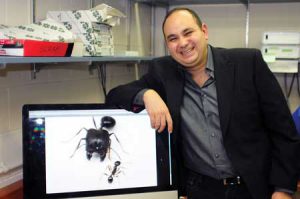
By Katherine Gombay
It took just eight ants for biologist Ehab Abouheif and his team to know they were onto something unusual. After 15 years spent in fields beside a highway in Long Island looking at ants from the Pheidole morrisi species, the researchers came across a number of specimens with huge oblong heads and giant vicious mandibles. “When I saw them, I thought, ‘Holy cow! Those are monstrous looking soldiers!’” says Abouheif. Not only did they have big jaws, they were also very ready to use them. According to Abouheif, “if they get you between the fingers, it really hurts.”
The remarkable thing is, these kinds of ants weren’t supposed to be there in the first place. Supersoldiers are normally found in only eight of the more than 1,100 Pheidole (big-headed ant) species, and all of them live in the southwestern U.S. and northern Mexico. They use their large heads and powerful jaws to protect the entrance to the nest from attackers.
In ant colonies, there are millions of workers. Depending on the food the ant larvae are fed, they then develop into soldiers or minor workers. So, after travelling to Arizona to collect some of the supersoldiers in species where they occur naturally, Abouheif and his team, along with colleagues from the University of Arizona, set out to see whether they could artificially induce ants to become supersoldiers. And they were very successful in doing so. The team discovered that by applying juvenile hormone to larvae at critical stages in their development, they were able to trigger the production of supersoldiers in at least three species in the genus where they have never been seen before. Moreover, these species are widely separated in the evolutionary tree of Pheidole.
This led Abouheif to hypothesize that, like the supersoldier ants that the research team had found in Long Island, some of the anomalies that appear in nature on a regular basis are in effect expressions of dormant ancestral genetic material.
“Birds with teeth, snakes with fingers, and humans with ape-like hair – these are ancestral traits that pop up regularly in nature,” Abouheif explains. “But for the longest time in evolutionary theory, these ancestral traits were thought to go nowhere – they were seen as the Barnum and Bailey of evolution, slips in development that reveal things from the past.”
These findings are groundbreaking for evolutionary theory, according to Abouheif, because they show there is dormant genetic potential that can be locked in place for a very long time.
“The kind of environmental stressors that evoke this dormant potential are there all the time – so when the need arises, natural selection can take hold of the potential and actualize it,” he explained. “So what we’re showing is that environmental stress is important for evolution because it can facilitate the development of novel phenotypes. Anytime you have a mismatch between the normal environment of the organism and its genetic potential you can release them – and these things can be locked in place for 30-65 million years.”
